Follow me:

Date posted: June 16th 2017
Book Title: Merchants of Doubt (continued)
The characters
As I said in the introduction this story is not easy to follow—lots of names and lots of dates—and I know that if I start naming names and recalling dates I’m not going to get the point across. So I’ll try to keep the dates in as much context as I can and I’ll try to stick to the important names only.
On that note, we definitely have to start with the four main merchants of doubt. These are the people who had the credentials, the reputation, the influence, and the economic means to steer political action (and public opinion) away from regulation. Their names: Frederick Seitz, Robert Jastrow, Bill Nierenberg, and Fred Singer. But we might as well call them Asshole # 1, Asshole # 2, Asshole # 3 and Asshole # 4. With number four being the biggest asshole of them all.

Sorry I couldn’t find better images. I don't want to get sued…
Click here to bring Asshole # 2 into focus
Asshole # 1 has no known copyright restrictions
Asshole # 3 is by Vickijean under Creative Commons license BY-SA 3.0 via Wikimedia Commons
and Asshole # 4 is by Hans Erren under Creative Commons license BY-SA 3.0 via Wikimedia Commons
These four sacks of shit have many things in common. They all are (or were) highly educated physicists with very accomplished careers in atomic physics or astrophysics, they also were children of the Manhattan Project1, and during the Cold War they all developed a passionate hatred towards communism. Additionally, they all had a blind faith in technology, and believed the acceleration of human progress could only be achieved through a free-market ideology. And last but not least, in their later years, they all stopped doing actual science—mainly because they constantly bumped heads with other scientists—so they moved to government advising positions (surrounded by politicians) where they felt right at home.
Asshole # 1 was the oldest, he was the first one to sharpen the six weapons of doubt we talked about, and he used them in favor of the Tobacco Industry. So let’s start with that story:
-
The US project that built the atomic bomb↩
-
Tar being one of the most common byproducts of tobacco burning↩
-
Although he did have to get the approval from the industry’s lawyers↩
-
Weapon 2, denial↩
-
Weapon 1, being a magician↩
-
Perhaps not the deployment of bomb itself, but definitely the fact that we developed the technology before the nazis did↩
-
Which makes the atomic bomb look like a firecracker↩
-
It would be like getting laser vision in a game of Marco Polo↩
-
He was like the anti‑Carl↩
-
The scumbag running for president against L B Johnson in 1963↩
The tobacco issue
Because of the complexity of this (and every other story in the book) I would like to start by showing you a little timeline of the most relevant events on this issue. As you read, you may want to come back to this picture, so please click here to open the picture in a separate tab—and feel free to take a look whenever you feel like you have lost track of time.
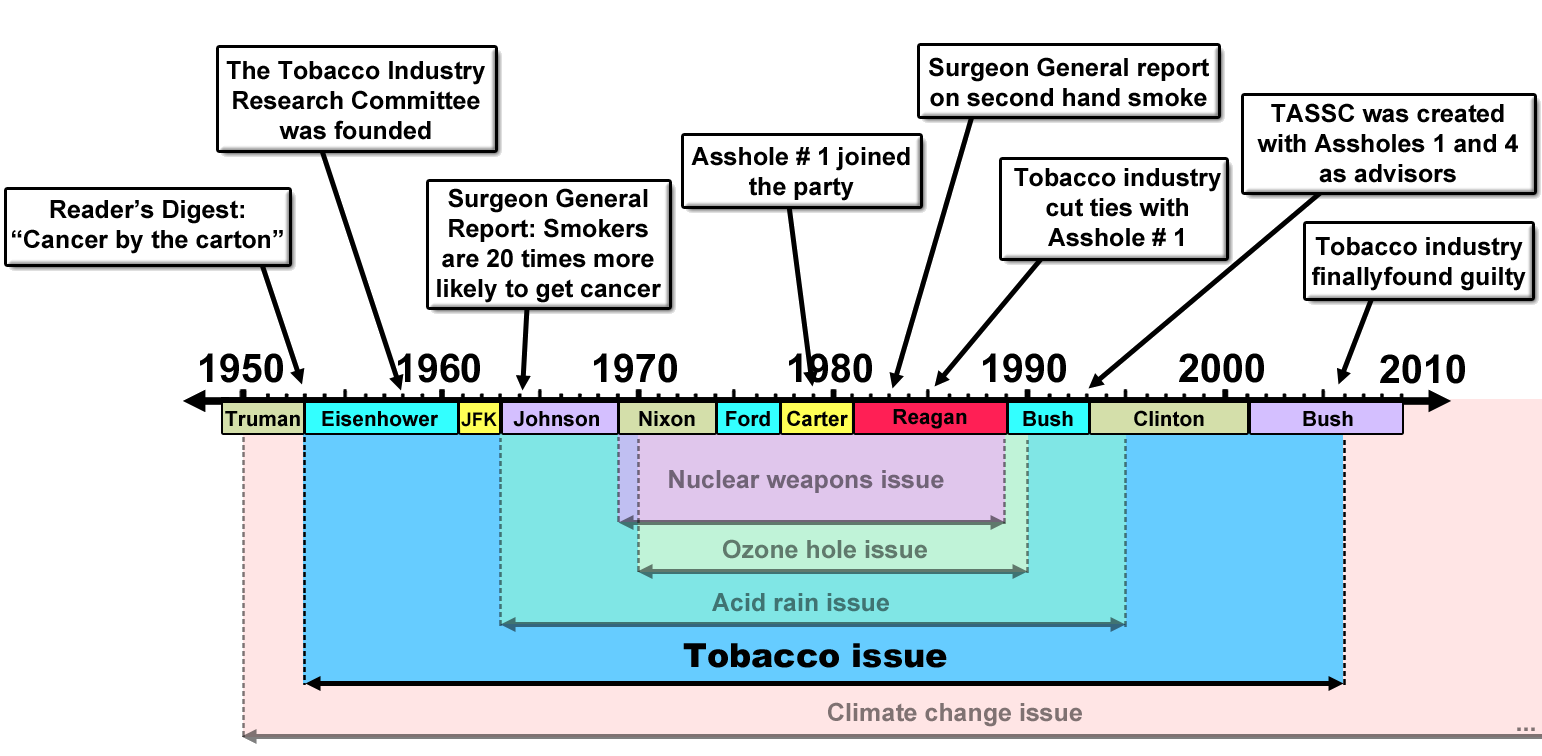
Timeline of the most relevant events from the tobacco issue
Image under Creative Commons Attribution-ShareAlike 4.0 International license via www.chasanabria.com
Tobacco has been a product of high demand since the colonial days, and after the industrial revolution it became a multimillion dollar industry with an ever growing revenue. But one day in 1953, cold sweat ran down the spine of most tobacco businessmen when a Reader’s Digest’s headline read “cancer by the carton”. The headline was the result of a study done on lab rats which were painted with a little bit of tar paint on their skin2. The results were almost all of the rats developing cancer, and it marked the beginning of a battle that the Tobacco Industry is still fighting today. However, back in the 1950’s they realized they couldn’t fight it alone, and they formed an alliance with Hill+Knowlton (a very respected consulting company) who immediately told them that they needed to fight back with “studies” of their own. Under this advice they founded ‘The Tobacco Industry Research Committee’ in 1958, which was (as they put it) a “research program devoted primarily to the public interest”.
It was under this fire, that they forged the weapons of doubt—starting with Weapon 1 (being a magician)—which consisted on asking certain questions that distracted the public opinion and made people wonder whether the cancer related studies were reliable. Questions like:
All valid questions, but all of them had answers. However, an answer was not what they were looking for. They asked these questions in very public scenarios where nobody could sit down and explain the science behind it without boring the audience to death. Besides most of the time they were one‑way conversations like pamphlets and magazine articles filled with open‑ended questions like those I just mentioned—leaving the reader utterly confused. For example, there was one booklet called “A scientific perspective on the cigarette controversy” which was sent to 176,800 doctors, and around 15,000 columnists, as well as some members of congress. These people didn’t know the answers (obviously), so they were just left there wondering… the doubt had been planted... On top of this, the Tobacco industry used Weapon 4 (the illusion of a debate) almost like a mafia, threatening media outlets with the consequences of not presenting both sides.
In the early 1960’s the government started looking deeper into this, and by 1964 the Surgeon General issued a report saying that smokers were 20 times more likely to get lung cancer. Today, nobody can deny that, but what did the Tobacco Industry do? Weapon 2 (denial), by 1969 the Tobacco Industry held firmly that there was “no demonstrated causal relationship between smoking or any disease”. Furthermore, they changed the name of the Tobacco Industry Research Committee to just ‘Tobacco Research Committee’, dropping the word ‘industry’ completely so people wouldn’t think they were related, and dumped about 7 million dollars for the dissemination of doubt.
It was a ruthless fight, but by the late 1970s the public opinion was leaning towards the notion of tobacco being a dangerous product. So by 1979 the Tobacco Industry realized that to endure on this battle they needed to fight science with science, or at least scientists. This was when Asshole # 1 came into the picture. He was given 45 million dollars to be distributed among university research groups of his choosing3 with the goal of developing “an extensive body of scientifically, well‑grounded data useful in defending the industry against attacks”.
Their most used approach was claiming that there was “no evidence”4 that lung cancer could be linked directly to tobacco because it could also be asbestos, radon, or just contamination5. Whatever it was, but definitely not their beloved cigarettes… This is a strategy that proved quite effective seeing that they held for over thirty years without losing a single case in court—even after they cut ties with Asshole # 1 in 1985).
We will continue this story later on, but for now I will spoil its ending by telling you that in 2006 the Tobacco Industry was found guilty for the first time in court despite the fact that we knew about the dangers of smoking since the 1950s. Today the World Health Organization finds that smoking is the probable cause of twenty five different diseases, that smoking is responsible for five million deaths a year, and that half of these deaths occur in middle age. But it took us over fifty years to reach this point. Why?. Well... there was a memo written by the Tobacco Industry executives in 1969 that said “doubt is our product”, that is why.

“I’d walk a mile for a camel” was the catchphrase for their
commercials
Image by Joe Haupt under Creative Commons license BY 2.0 via Flickr
The nuclear weapons issue
No one can deny that the atomic bomb saved us from the evil clutches of fascism6. But after the war, most of the physicists that contributed to its creation started realizing that an uncontrolled fabrication of these weapons of mass destruction was a terrible idea—and that the worldwide number of nuclear weapons needed to be kept to a minimum. Most physicists except Asshole # 1 of course. This guy felt deep down in his sad little heart that if we didn’t make a ton of bombs, the soviets would soon take over the world. Convinced about this, he joined forces with Edward Teller (the father of the hydrogen bomb7) to persuade the White House, and the general public, into believing that we must do whatever it takes to have nuclear superiority in order to be protected from the dangers of communism and socialism. Here’s the timeline:
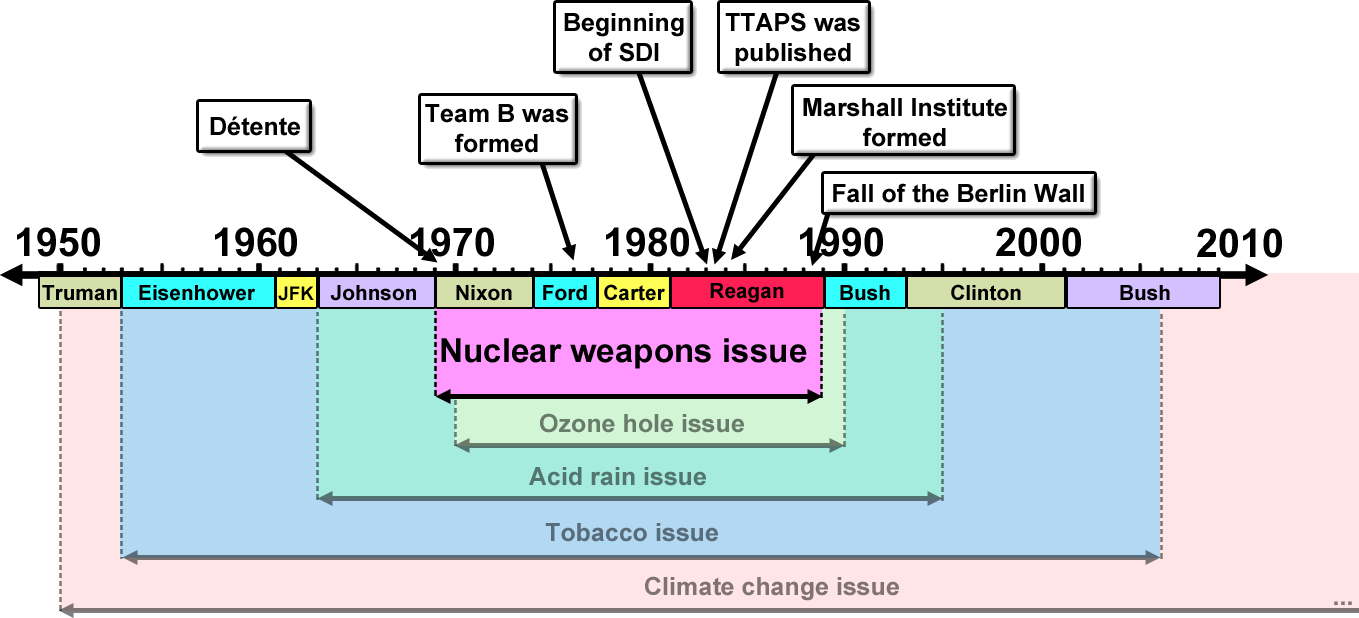
Timeline of the most relevant events from the nuclear weapons issue
Image under Creative Commons Attribution-ShareAlike 4.0 International license via www.chasanabria.com
In 1969, at the beginning of the Nixon administration, there was an effort to ease the geopolitical tension between the Soviet Union and The United States. This was called Détente (which means relaxation in French), and it had the ultimate goal of reducing the world’s nuclear weapon stockpile. However, many conservative think tanks opposed this effort. Asshole # 1 and Ed Teller were the poster children of these think tanks, and did everything in their power to persuade everyone into thinking that since we didn’t know what the Soviets were up to, we had to assume the worst.
They were right on the first part—we didn’t know what the Soviets were up to—so the Central Intelligence Agency (CIA) stood up to the challenge. They later issued a report saying that (according to what they could gather) the US was superior on all fronts. But Asshole # 1 and Ed Teller didn’t believe this. They demanded for another agency to assess the threat, and so the Defence Intelligence Agency (DIA) gathered what they could and issued a report which disagreed with that of the CIA. The curious thing is that it didn’t disagree on the strength of the Soviet defenses, it disagreed on the cost. So according to the DIA the Soviet army had cost them twice as much. Either way, the US was superior.
But because of this disagreement, a team of “experts” was formed in 1976 to review the multiple studies done on the Soviet military capabilities. This review panel was called the ‘Team B’ and unfortunately had bunch of people who were already thinking that the CIA estimates were underplaying the Soviets. Plus, to make matters worse, Ed Teller was their reviewer.
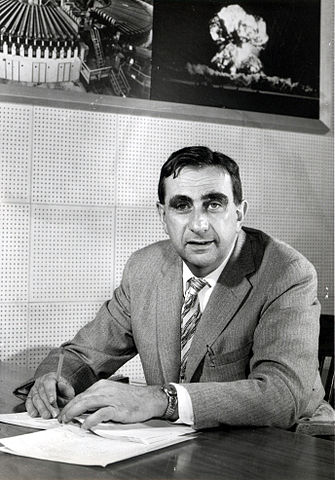
Edward Teller, the father of the hydrogen bomb and one of the few physicist of the Manhattan project who didn’t discourage the use of nuclear weapons.
Image under Public Domain via Wikimedia Commons
Team B turned out to be a bad idea, its entire panel was composed of neoconservative and pro‑war advocates who were driven by a communophobic paranoia. They constantly claimed that the Soviets were getting stronger, and that they would soon be superior to the US in nuclear matters—with little proof given to these claims.
Their main strategy was taking advantage uncertainties and using Weapon 3 (cherry picking) to make alarming statements. For example, both the US and the Soviets were working hard on developing a new mechanisms for submarine detection different to the one used today: the Sonar. This would be advantageous because a submarine with sonar gives its position away every time it turns its sonar on. For this reason, a different detection mechanism (unknown to one’s enemies) was highly desired; because it would allow one to see without being seen8. Such mechanism was never found, but amidst the paranoia, the Team B concluded that the low number of Soviet submarines detected could only mean that the Soviets HAD found that magical detection mechanism—instead of simply realizing that the Soviets just didn’t have as many submarines. C. S. Lewis (the writer) summarised this kind of thinking as “The very lack of evidence is thus treated as evidence; the absence of smoke proves that the fire is very carefully hidden”...
Team B was doing the opposite of what the Tobacco industry was doing. This is why Weapon 3 can go both ways, you can cherry pick the uncertainties and say “look, we can’t draw conclusions here, there is too much uncertainty” (as the tobacco companies were doing with lung cancer), OR, you can cherry pick a small detail and say, “Aha! This means that our suspicion is totally true” (as Team B was doing regarding the Soviet’s nuclear arsenal).
Fortunately president Carter didn’t pay much attention to this group of lunatics, however, when Reagan took office in 1981, he totally did. Reagan even made a few of these cock suckers his advisors, and together (in March 1983) they came up with the idea known as the Strategic Defense Initiative (SDI), or more commonly known as Star Wars.
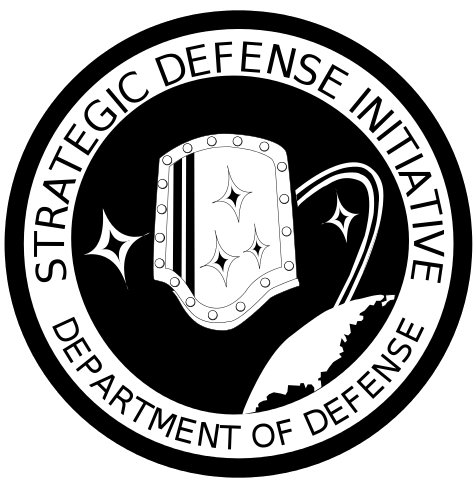
The logo of the Strategic Defense Initiative satirically labeled as “Star Wars”.
Image under Public Domain via Wikimedia Commons
Star Wars had the goal of building a giant web of satellites that would shoot down any missile coming from the Soviets. Not surprisingly, this turned out to be a terrible idea. First of all the technology wasn’t even proven, and it would take decades to build. Second, it would probably provoke the Soviets. Is like being the middle school nerd and announcing to the whole class that your parents will buy you a giant bubble...tomorrow...so that the bully will never be able to punch you in the stomach again. What do you think the bully going to do? Well, either punch you in the stomach right now, before the you get the bubble. Or worse, bring a huge needle tomorrow, pop the bubble, and punch you in the stomach—over and over again—for trying to outsmart him.
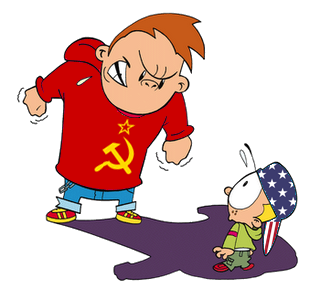
Team B’s view of the Cold War
Image slightly modified from its original version by Pimkie under Creative Commons license BY 2.0 via Flickr
Nonetheless, what happened next was pretty cool. Essentially every scientists with the credentials to build such a defense system gave Reagan the middle finger. The main flaw was that you only need ONE warhead to make it through the shield in order to destroy an entire city! And the soviets had the ability to deliver about 8,000 warheads (at the time)… Most likely one of those 8,000 warheads would make it past this magical shield that Reagan and his Team B of assholes had in mind. Besides, how do you test such a system? Do you shoot a bunch of missiles at yourself to see if they get stopped? What if the shield fails? (as space‑related thing often do).
The opposing team of scientist was in part lead by Carl Sagan who wrote a scientific paper exploring the possible outcomes of a nuclear exchange. The paper was published shortly after Star Wars was announced, and was later known as TTAPS (an acronym made from the last names of all the authors). In the paper they explained how a nuclear war could end up in a mass extinction of the Earth’s species. Not because of the blasts themselves, but because of the dust and smoke that would come up after the explosions. The explanation is simple. You see, the asteroid that wiped out the dinosaurs didn’t do so because of the impact itself, it did so because of the huge cloud of dust and smoke that engulfed the Earth for many months after the impact. This cloud cooled down the atmosphere significantly and created acid rain all over the place. The lack of sunlight and the poisonous atmosphere killed the dinosaurs, and spared a few mammals who would later conquer the Earth. TTAPS claimed that something similar could happen if a few nuclear warheads exploded—leaving a few cockroaches to conquer the Earth. They called it the “Nuclear Winter” hypothesis, and it was a very controversial topic. Especially because Carl published a summary of the paper in the Parade magazine a few days before the paper itself was published—and Carl didn’t try to sugarcoat anything.
As expected, our merchants of doubt fought back. They brought in a new team member: Asshole # 2, who (like Asshole # 1) hated communism, and believed that technology could solve everything. He was also a very famous astrophysicist commonly seen in television (just like Carl9), and he knew exactly what they had to do. If the Tobacco Research Institute had worked to defend the Tobacco Industry, why not make a similar institute to defend Reagan’s stupid little shield? They called it the George C. Marshall Institute, founded in 1984. And with their influence they eventually convinced congress to approve Star Wars—even though no one knew who was going to build it.
Their weapon of choice at this point was Weapon 6 (attack the weak link). You see, it turns out TTAPS (the initial study on Nuclear Winter) was not as accurate as it could have been. Newer versions of these models later adjusted the predictions and showed that instead of having a temperature drop of 20°C, a more realistic Nuclear Winter would go down about 10°C—because of some heat exchange that happens with the ocean. These kind of things are very common in science: when new evidence is found or new things are considered, the hypotheses can be adjusted. It is perfectly normal, but it does make our confidence levels look weak in the eyes of those who don’t know how the scientific method works. The merchants of doubt knew this very well, so they attacked this weak link and claimed that the whole hypothesis was full of crap!
They eventually brought in Asshole # 3 into the mix, and the battlelines were drawn: The George C. Marshall institute vs. The Union of Concerned Scientists. The Marshall institute was the minority in this case, but these Davids feared no Goliath, they knew that all they had to do was create the illusion of a debate and use the fairness doctrine to defend their side (Weapon 4). They also found several instances in which to use Weapon 5, exaggeration. One of them was when Henry Kendall, the founder of The Union of Concerned Scientists, got a letter from the Soviet Secretary General (Mikhail Gorbachev) in which Gorbachev congratulated Kendall for his “noble activities in the cause of peace”. The George Marshall Institute obviously blew this letter out of proportion and claimed that all of those against Star Wars were promoting communism...What an easy thing to say...
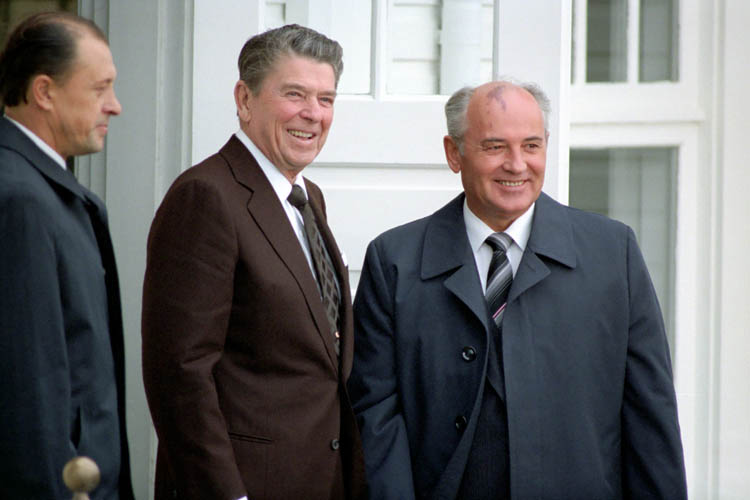
President Ronald Reagan and Soviet Union General Secretary Mikhail Gorbachev in 1986.
Image under Public Domain via Wikimedia Commons
This was the birth of that right‑wing belief which claims scientists and environmentalists are on a mission to steer the world towards socialism, or even worse, communism. From here on, environmentalists were seen as enemies of free‑market and free‑enterprise, and (in the eyes of right‑wing extremists) they were planning a massive attack on capitalism. Science became “a left‑wing conspiracy”.
The Star Wars “debate” was kept alive throughout Reagan’s second administration with the right‑wing constantly accusing scientists of being motivated by a political agenda. What they failed to recognize was that their aggressive Star Wars push was 100% motivated by a right‑wing political agenda. As Barry Goldwater10 once said “Extremism in the defense of liberty is no vice”. A sentence that in this modern society can raise few eyebrows.
In the end, the Cold War ended with the fall of the Berlin Wall in November 9, 1989 and Star Wars was never needed. But as the Cold War ended, the war on environmentalism had began.
In hindsight, it looks like the right‑wing was determined to do whatever it took to preserve their vision of freedom—and what the humble scientist were asking them (through their studies) was: “even if you destroy the world in the process?”
Click on the next button to keep reading
